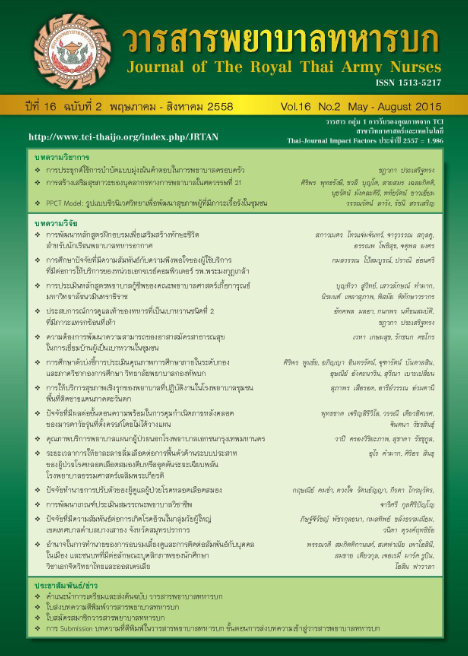PPCT Model: รูปแบบชีวนิเวศวิทยาเพื่อพัฒนาสุขภาพ ผู้มีภาวะเจ็บป่วยเรื้อรังในชุมชน PPCT Model: Bioecological Model for Developing Health of People with Chronic Conditions in the Community
Keywords:
รูปแบบชีวนิเวศวิทยา, บรอนเฟนเบรนเนอร์, การพัฒนาสุขภาพ, ผู้มีภาวะเจ็บป่วยเรื้อรัง, ชุมชน, Bio-ecological Model, PPCT Model, Health development, People with Chronic Conditions, CommunityAbstract
ภาวะเจ็บป่วยเรื้อรังเป็นปัญหาสาธารณสุขที่สำคัญทั่วโลก การพัฒนาสุขภาพผู้มีภาวะเจ็บป่วยเรื้อรังระยะยาวในชุมชนจึงเป็นสิ่งที่จำเป็น บทความนี้ผู้เขียนได้นำเสนอรูปแบบชีวนิเวศวิทยาของบรอนเฟนเบรนเนอร์ ซึ่งมี 4 องค์ประกอบหลักที่สำคัญรวม เรียกว่า ‘Process-Person-Context-Time Model (PPCT Model)’ โดย ‘กระบวนการ’ สะท้อนการมีปฏิสัมพันธ์ระหว่างบุคคลที่เป็นศูนย์กลางของระบบกับบริบทแวดล้อมรอบตัว สำหรับ ‘บุคคล’ ถูกวางให้เป็นศูนย์กลางของระบบ ส่วน ‘บริบทแวดล้อม’ คือ สิ่งแวดล้อมที่อยู่ล้อมรอบ‘บุคคล’มี 4 ระบบ ได้แก่ ระบบเล็ก ระบบกลาง ระบบนอก และระบบใหญ่ และ ‘เวลา’ เป็นองค์ประกอบสุดท้ายที่มีผลต่อการเปลี่ยนแปลงพัฒนาของบุคคลได้ตลอดระยะเวลาภายใต้สภาพแวดล้อมที่มีรอบตัว ซึ่งรูปแบบนี้มีประโยชน์มากในการนำไปใช้เป็นกรอบแนวคิดในการอธิบายปรากฏการณ์ที่ซับซ้อน และพัฒนากลยุทธ์การดูแลสุขภาพผู้มีภาวะเจ็บป่วยเรื้อรัง ดังนั้น พยาบาล และบุคลากรด้านสุขภาพควรได้นำรูปแบบดังกล่าวไปประยุกต์ใช้ในการพัฒนาการปฏิบัติงาน และการวิจัยการดูแลผู้มีภาวะเรื้อรัง เพื่อนำไปสู่การพัฒนาคุณภาพชีวิตที่ดีของผู้มีภาวะเจ็บป่วยเรื้อรังในบริบทของครอบครัวและชุมชนต่อไป
t-text-stroke-width: 0px; "> Chronic condition is an important problem around the world. Therefore, long term care development in the community is needed. The aim of this article is to propose the model, created by Urie Bronfenbrenner,
composed of 4 components, namely ‘Bioecological Model’ or ‘Process-Person-Context-Time Model’ (PPCT Model). The term ‘Process’ refers to the interactions between the person at the centre of the model and the environments around them. A ‘Person’ is located at the centre of model. ‘Context’ refers to the environment as ‘nested systems’ known as _ micro-system, meso-system, exo-system, and macro-system in which the person is located. The last element is ‘Time’, explanation for changes occur as time progresses. Using this model as a framework for exploring complex phenomena and developing appropriate strategies to improve health of people with chronic condition is very benefit. Hence, nurses and health personnel should be concerned, apply it in their works, and do it in the research on caring for people with chronic conditions in order to enhance their quality of life under family and community contexts.
Downloads
Downloads
How to Cite
Issue
Section
License
บทความหรือข้อคิดเห็นใดใดที่ปรากฏในวารสารพยาบาลทหารบกเป็นวรรณกรรมของผู้เขียน ซึ่งบรรณาธิการหรือสมาคมพยาบาลทหารบก ไม่จำเป็นต้องเห็นด้วย
บทความที่ได้รับการตีพิมพ์เป็นลิขสิทธิ์ของวารสารพยาบาลทหารบก
The ideas and opinions expressed in the Journal of The Royal Thai Army Nurses are those of the authors and not necessarily those
of the editor or Royal Thai Army Nurses Association.






